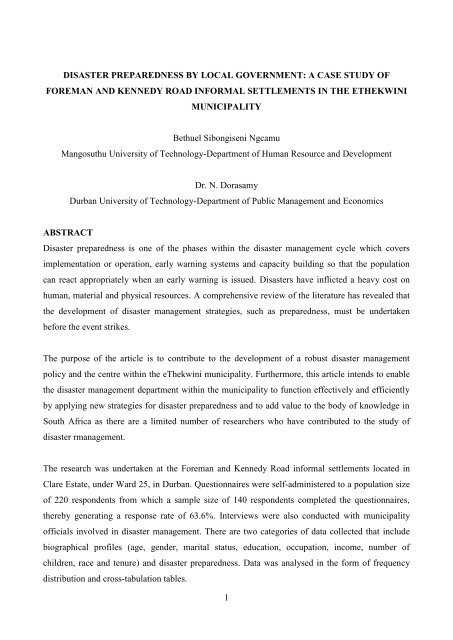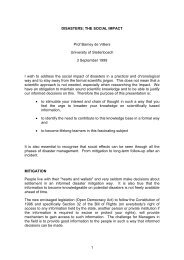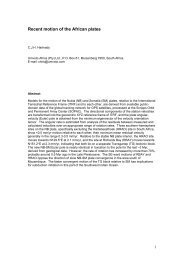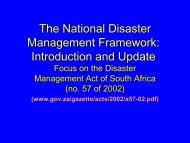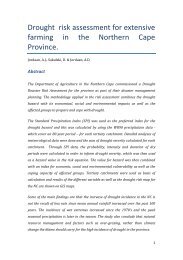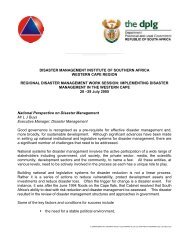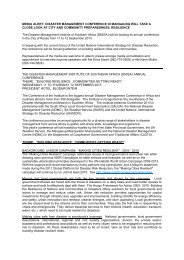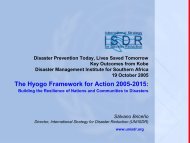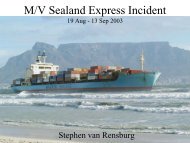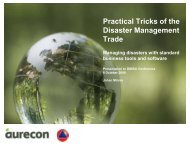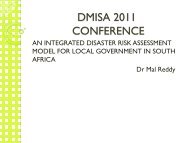BS Ngcamu, Dr. N Dorasamy - Disaster Management Institute South ...
BS Ngcamu, Dr. N Dorasamy - Disaster Management Institute South ...
BS Ngcamu, Dr. N Dorasamy - Disaster Management Institute South ...
- No tags were found...
You also want an ePaper? Increase the reach of your titles
YUMPU automatically turns print PDFs into web optimized ePapers that Google loves.
DISASTER PREPAREDNESS BY LOCAL GOVERNMENT: A CASE STUDY OFFOREMAN AND KENNEDY ROAD INFORMAL SETTLEMENTS IN THE ETHEKWINIMUNICIPALITYBethuel Sibongiseni <strong>Ngcamu</strong>Mangosuthu University of Technology-Department of Human Resource and Development<strong>Dr</strong>. N. <strong>Dorasamy</strong>Durban University of Technology-Department of Public <strong>Management</strong> and EconomicsA<strong>BS</strong>TRACT<strong>Disaster</strong> preparedness is one of the phases within the disaster management cycle which coversimplementation or operation, early warning systems and capacity building so that the populationcan react appropriately when an early warning is issued. <strong>Disaster</strong>s have inflicted a heavy cost onhuman, material and physical resources. A comprehensive review of the literature has revealed thatthe development of disaster management strategies, such as preparedness, must be undertakenbefore the event strikes.The purpose of the article is to contribute to the development of a robust disaster managementpolicy and the centre within the eThekwini municipality. Furthermore, this article intends to enablethe disaster management department within the municipality to function effectively and efficientlyby applying new strategies for disaster preparedness and to add value to the body of knowledge in<strong>South</strong> Africa as there are a limited number of researchers who have contributed to the study ofdisaster rmanagement.The research was undertaken at the Foreman and Kennedy Road informal settlements located inClare Estate, under Ward 25, in Durban. Questionnaires were self-administered to a population sizeof 220 respondents from which a sample size of 140 respondents completed the questionnaires,thereby generating a response rate of 63.6%. Interviews were also conducted with municipalityofficials involved in disaster management. There are two categories of data collected that includebiographical profiles (age, gender, marital status, education, occupation, income, number ofchildren, race and tenure) and disaster preparedness. Data was analysed in the form of frequencydistribution and cross-tabulation tables.1
INTRODUCTIONDeveloping countries, such as <strong>South</strong> Africa, have often failed to implement disaster managementstrategies such as preparedness. Political neglect, social marginalization and limited access toresources compel helpless people to live and work in hazard-prone areas. <strong>Dr</strong>awing on cases fromthe developing world, scholars such as O’Keefe, Westgate & Wisner (1976:45), Hewitt (1983:45)and Wisner, Blaikie, Cannon & Davis (2004:65) argue that people’s behaviour in the face of naturalhazards is constrained by social, economic and political forces rather than individual riskperception. Government is accountable to citizens for quality service delivery such as housingprovision. The Constitution of the Republic of <strong>South</strong> Africa, 1996 (chapter 7:152), requires localgovernment as a sphere of government to provide democratic and accountable government to localcommunities, ensure the provision of services to communities in a sustainable manner, promotesocial and economic development, promote a safe and healthy environment; and encouragecommunities and community organisations in matters of local government (Armstrong, 2005:2).Government accountability to all citizens translates to improving the lives of the poor and thevulnerable. Local governments require the assistance of structures involving all disasterpractitioners and specialists dedicated to monitoring and improving disaster preparednessapproaches.The Foreman and Kennedy Road informal settlements are prone to emergencies and disasters suchas floods, fires and storm surges which negatively impact on people living in these vulnerable areas.International experiences of disasters depict that different countries are struck by floods,earthquakes and volcanoes. International declarations and proposals by the United NationsDevelopment Programme and other organisations dealing with disaster risk reduction plays atremendous role in disaster preparedness. Furthermore, the role of non-governmental organisations(NGOs), such as the International Red Cross and the role played by the United States of America(USA) in disaster preparedness, assist countries struck by catastrophies with preparednessstrategies.If disaster frequency is to be reduced, then safety must also be sought as a major goal incomprehensive strategic planning to reduce disasters. <strong>Disaster</strong> identification and reduction at aninternational level and national level must be supplemented by local activities. The Centre forResearch on the Epidemiology of <strong>Disaster</strong>s (2006:1) states that, disaster preparedness often failsbecause it is rarely evidence based. It suggested that more scientific studies are needed to improvethe effectiveness of disaster preparedness and prevention. Some disasters can be avoided and2
minimized through enhancing the national disaster management capacities to address the variousaspects of prevention, preparedness, mitigation, response, rehabilitation and recovery. Holloway(2003:34) argues that disaster risk reduction is the systematic development and application ofpolicies, strategies and practices to minimise vulnerabilities and disaster risks throughout society toavoid (prevent) or limit (mitigate and be prepared for) the adverse impact of hazards, within thebroad context of sustainable development. Haddow & Bullock (2006:167) emphasise that there arethree sets of actions that can reduce losses. These actions are hazard mitigation, emergencypreparedness and recovery preparedness practices.This article seeks to investigate disaster preparedness within eThekwini Municipality. Thefragmented management of disaster actions such as preparedness has contributed to unnecessarymorbidity, mortality, and a waste of resources. However, some disasters can be avoided andminimised by enhancing the national disaster management capacities to address the various aspectsof preparedness. Informal settlement growth in metropolitan areas of <strong>South</strong> Africa has increased inthe past decade as a result of the abolishing of legislation implemented by the apartheid governmentthat prevented urbanisation (Ferreira, de Meyer, Loots & Keyise, 2002:23). The article will explorewhether disaster preparedness strategies are adequately implemented in informal settlements withthe aim to avoid, prevent and mitigate the impacts of disasters.Previously, preparedness strategies were ignored because disaster management was responding toand recovering from the disaster impact as disasters were governed by reacting Civil Protection Act67 of 1977 and the Fundraising Act 107 of 1978. Thus, with the enactment of the <strong>Disaster</strong><strong>Management</strong> Act 57 of 2002, disaster preparedness ensures that appropriate systems, proceduresand resources are in place to provide effective assistance to disaster victims, thus facilitating reliefmeasures and rehabilitation services. The focus of disaster management is to reduce the risk posedby actual and potential hazards. Hazards can be broadly grouped into three areas such as natural,technological and complex emergencies (Alexander, 2002b).Global approach to disaster management<strong>Disaster</strong> management strategies are traced back to antiquity when early hieroglyphics depictcavemen trying to deal with disasters. The Holy Bible speaks of the many disasters that hinderedcivilisations. Haddow and Bullock (2006:1) mention the account of Moses parting the Red Sea which can beinterpreted as the first attempt at flood control. Genesis 6 verse 14 (Zodhiates, Baker and Kemp, 1996: 10)speaks about Noah and the Ark, when he built an ark from cypress wood, coated it with pitch inside and out,3
as a mitigation strategy for the forthcoming predicted floodwaters. Moreover, the holy Bible speaks of manydisasters that hindered civilisations.Early disaster management strategies include inter alia, the promulgation of the United State ofAmerica (USA) Congressional Act of 1803 which was passed to provide financial assistance to a NewHampshire town that had been devastated by fires (Haddow et al., 2006:2). Another notable example is thatof the cold war era where the nuclear war was seen as a potential disaster threat. <strong>Disaster</strong> preparednessattempt to forecast extreme events, attempt to mitigate the impact of disasters, respond to disastersand cope with consequences of disasters. Strategies for disaster preparedness include awareness ofevent that is most likely to happen at a particular time and at a specific geographical location, riskand vulnerability assessment, response mechanisms, coordination, information management, andthe implementation of early-warning systems International Federation of Red Cross and RedCrescent Societies (IFRC), 2000:34).Allen (2006), cited in Yohe, Lasco, Arnell, Cohen, Hope, Janetos & Perez (2007:820) indicates thatthe bottom-up approach to disaster risk reduction is based on enhancing the capacity of localcommunities to adapt to and prepare for disasters. Actions in this approach include dissemination oftechnical knowledge and training, awareness raising, accessing local knowledge and resources, andmobilizing local communities. Blanco (2006), cited in Yohe et al. (2007:820), attests that climatechange can be incorporated in this approach through awareness and the transmission of technicalknowledge to local communities. Bridging the gap between scientific knowledge and localapplication is a key challenge.The International Federation of Red Cross and Red Crescent (2000:6) indicate that vulnerabilityanalysis is useful because information is needed in the pre-disaster phase including collecting andanalysing information necessary for preparedness planning. The International Federal of Red Crossand Red Crescent Societies (2000:6) indicate that disaster program planners increasingly usevulnerability information to refine their preparedness plans. Furthermore, vulnerability analysisideally provides indications of where the effects of disasters are likely to be the most pronounced(for example, by region and population). It is important for development planners to make someeffort to quantify the tangible aspects of vulnerability and loss to assist preparedness planning.Local experience is a good guide to what is vulnerable in a society, and the list of potentiallyvulnerable elements should be supplemented by a study of written reports and the knowledge ofthose who lived through previous disasters (Coburn, Pomonis, Sakai & Spence, 1991:32). This4
indicates that tacit (indigenous) knowledge received on previous disasters in a particular area needsto be recorded and converted to explicit knowledge for future use.In this regard, Coburn et al. (1991:33) point out that assessment includes the following two generalcategories of information:• Static infrastructure information that provides the basis for determining the extent ofdevelopment, types of physical advantages and disadvantages faced by communities residingin an area, and a “map” of available structures (such as roads and hospitals) that might beuseful in times of emergences; and• Relatively dynamic socioeconomic data indicating causes and levels of vulnerability,demographic shifts and types of economic activity.International agreements, such as the International Decade for Natural <strong>Disaster</strong> Reduction 1990-1999 (IDNDR), Yokohama Strategy (1994), International Strategy for <strong>Disaster</strong> Reduction (ISDR),Hygo Framework for Action (2005-2015), and <strong>Disaster</strong> Reduction and Recovery Programme(DRRP), emphasise the importance of disaster preparedness. The United Nations (UN) promotespreparedness, prevention and mitigation activities through its regular development projects. The UNis encouraging the building of early warning systems and conducting monitoring and forecastingroutines which are working to increase local capacity to adequately boost local and regionalpreparedness (Haddow et al., 2006:222).In developed countries, the social implications of disasters are not severe because disastermanagement and disaster risk-reduction strategies are in place. For instance, the Tulsa Safe Roomprogramme provided mitigation and preparedness in the United State of America (USA). TheFederal Emergency <strong>Management</strong> Agency (FEMA) and private organisations funded the building ofsafe rooms to provide shelters during tornadoes as a preparedness and mitigation strategy. Anothercase is the implementation of disaster risk reduction which is risk assessment. In the case of therelocation of the Castaic Union school district in the USA, which was previously located at theearthquake belts zone and also built below the dam and the reservoir, it was later relocated to theless vulnerable area (Haddow et al., 2006:223). In developed countries, there are also good publicprivatepartnerships which help for disaster preparedness and mitigation programmes.5
<strong>Disaster</strong> preparedness and informal settlementsInformal settlements are deemed by the United Nations as areas where groups of housing have beenconstructed on land to which the occupants have no legal claim. These areas are characterised byrapid, unstructured and unplanned developments. They are common features of developingcountries and are typically the product of an urgent need for shelter by urban poor (Huchzermer,2001; Mason & Baltsavias, 1997 & United Nations, 2004). According to information from the<strong>South</strong> African 1996 census, 11, 6% of households lived in freestanding informal settlements, and afurther 4.5% lived in shacks in the backyards of formal houses in townships. Over 16% ofhouseholds were living in urban informal housing, and a further 18% lived in traditionallyconstructed houses which would be located mostly in rural areas. Napier & Rubin (2002:4) arguethat these figures are only broadly indicative of exposure to risk, because the location of thesettlements and the quality of the construction materials are not all evident. Informal settlementgrowth in metropolitan areas of <strong>South</strong> Africa has increased in the past decade as a result of theabolishing of legislation implemented by the apartheid government that prevented urbanisation(Ferreira et al., 2002:23). As a result of the sudden post-apartheid increase in urbanisation,metropolitan areas in <strong>South</strong> Africa were very dynamic, resulting in the rapid change of the spatialpatterns and land use associated with such areas.The 11.6% households living in freestanding informal housing are most often located on the fardistant peripheries of cities (SA Census, 1996). Vulnerability to disaster is increased as a result ofcertain qualities of the location, such as settlements on steep slopes (Inanda, Durban), within floodplains (Alexandra, Johannesburg), close to mine dumps (East Rand, near Johannesburg), close toheavy industrial areas (Wentworth, Durban), or even on landfill sites (Foreman and Kennedy Road,Durban). Other hazards arise from the nature of the settlement itself, such as risks of rapidlyspreading fire, or health risks from rising dampness, poor indoor air quality and collapsingstructures.According to the National <strong>Disaster</strong> <strong>Management</strong> Centre (NDMC) (2006/2007:12-13), naturaldisasters such as devastating floods, violent hailstorms, heavy snowfalls and gale-force winds areregular occurrences in <strong>South</strong> Africa. The <strong>South</strong> African Weather Service maintains a record ofsignificant weather events of the past and captures information such as the actual date ofoccurrence, the extent of the damage and areas affected, as well as the frequency of a particular typeof disaster occurring in a specific region. Such records are essential to government departments6
dealing with the implementation of disaster management strategies (such as prevention andpreparedness) in vulnerable areas.There are four parts to a preparedness programme which encapsulates planning, training andeducation, resource management and exercising, which refers to the physical training of thepersonnel such as fire marshals. Bullock & Perry (2000:34), cited in Haddow & Bullock(2007:168), found that another way to reduce a disaster’s physical impact is to adopt emergencypreparedness practices, which can be defined as pre-impact actions that provide the human andmaterial resources needed to support active responses at the time of the hazard’s impact. Accordingto Wu & Lindell (2003:2), community protection works include dams, levees, and drainage systemsthat protect an entire area from the hazard’s impact. Community protection works are mostcommonly used to divert floodwater past communities that are located in floodplains. They also canbe used to provide protection from other types of water flows such as tsunami and hurricane stormsurges (Haddow & Bullock, 2007:196). eThekwini municipality is dominated by a very highdensity of drainage system whereas its geographical location is in a valley flow and large numbersof houses are built on the floodplains without any community protection works, especially in poorinformal settlements. Haddow & Bullock (2007:196) argue that community protection works canprotect against two types of geophysical hazards: landslides and volcanic lava flows, and someindustrial hazards. They further list four types of flood control works which are streamchannelisation, dams, levees and floodwalls (Haddow & Bullock, 2007:196-197).<strong>Disaster</strong> preparedness within the context of disaster managementAccording to Col (2007:115), preparedness is the state of readiness to respond to an emergencybased on planning, training, and exercise. The concept of disaster preparedness encompassesmeasures aimed at enhancing life safety when a disaster occurs, such as protective actions during anearthquake, hazardous materials’ spill, or a terrorist attack. It also includes actions designed toenhance the ability to undertake emergency actions to protect property and contain disaster damageand disruption, as well as the ability to engage in post-disaster restoration and early recoveryactivities (Tierney & Sutton, 2006:3). With regard to management response, the Manitoba HealthDepartment (2002:29) mentions the following two aspects of preparedness:• emergency response plan which deals with meeting the special demands created by an impact onthe community; and• business continuity planning to ensure services are maintained when the organisation is negativelyaffected by disasters, even if the effects are limited to internal disruptions.7
Emergency response planning deals with how the municipality will help its clients cope with theextraordinary demands that a disaster creates. In contrast, business continuity planning deals withhow the municipality copes with the impact of the disaster with its own systems and resources(Manitoba Health Department, 2002:30).Another component of response preparedness is to bring the skills, knowledge, functions andsystems together and apply them against event scenarios (Manitoba Health Department, 2002:31).This means that all government departments and different stakeholders should meet and integratetheir knowledge and expertise in preparation for any catastrophe. Furthermore, private and publicorganisations should prepare their internal disaster management pro-active plans with the aim ofavoiding or mitigating any risk or disaster. The recent earthquake that devasted Haiti resulted in anestimated 230 000 deaths with many more people left injured and displaced. The tragic situation inHaiti has raised key issues on the preparedness of <strong>South</strong> Africa’s disaster management departmentsin dealing with these catastrophies, particularly at the municipality level.In the <strong>South</strong> African context, the term ‘disaster risk management’ refers to the integrated, multisectoraland multidisciplinary administrative, organisational, and operational planning processes aswell as capacities aimed at lessening the impact of natural hazards and related environmental,technological and biological disasters. According to the <strong>South</strong> African <strong>Disaster</strong> <strong>Management</strong> Act2002 (57 of 2002), disaster management means a continuous and integrated multi-sectoral, multidisciplinaryprocess of planning and implementation of measures aimed at preventing or reducingthe risk of disasters, mitigating the severity or consequences of disasters, emergency preparedness, arapid and effective response to disasters and post-disaster recovery and rehabilitation. However, theterms disaster risk management and disaster management are used interchangeably in this article(NDMC, 2006/2007:12).The <strong>Disaster</strong> <strong>Management</strong> Act 2002 (Act 57 of 2002) gives priority to the application of theprinciple of cooperative governance for the purpose of disaster risk management and emphasizesthe involvement of all stakeholders in strengthening the capabilities of national, provincial andmunicipal organs of state to reduce the likehood and severity of disasters. The Department ofAgriculture has rolled out an awareness programme to raise awareness and educate farmingcommunities about disaster risk-reduction principles. Furthermore, the department issues earlywarning information (National Airways Corporation monthly advisories) and daily extreme weather8
warnings, including precautionary measures for different hazards which are loaded on the NationalDevelopment Agency (NDA) and Agricultural Geo-referenced Information System (AGIS)(NDMC, 2006/2007:82). The National Department of Health has a <strong>Disaster</strong> <strong>Management</strong> Sub-Committee which focuses on pre-hospital, forensic pathology and in-hospital disaster preparednesssign-offs, policies and procedures as well as training with an emphasis on institutional capacity andinstitutional disaster management or preparedness planning (NDMC, 2006/2007:83). Furthermore,training workshops and capacity building programmes are conducted by government officials, nongovernmentalorganisations (NGOs), and academic institutions which deal with disastercontingency planning and its linkages between disaster and development.The National <strong>Disaster</strong> <strong>Management</strong> Centre (NDMC) is the highest administrative and executiveauthority for disaster management in <strong>South</strong> Africa. The objective of the NDMC is to promote anintegrated and coordinated system of disaster management, with special emphasis on preventionand mitigation by national, provincial and municipal organs of state, statutory functionaries andother role-players involved in disaster management and communities (NDMC, 2006/2007:12). TheEmergency Operations Committee (EOC) was established in 2004 to co-ordinate internationalresponse to disasters as and when required. Furthermore, the use of technology is used as an earlywarning system and its translation into understandable language to the communities at risk.Geographical Information Systems (GIS) plays a critical role in the development of the National<strong>Disaster</strong> <strong>Management</strong> Centre (NDMC), which also enhanced <strong>Disaster</strong> <strong>Management</strong> InformationSystems (DMIS). The system can be seen as an all encompassing Information Technology (IT)solution that relates to various aspects of hazard analysis, vulnerability assessment, risk reduction,contingency planning, incident reporting systems as well as early warning systems (NDMC,2006/2007:26-27).<strong>Disaster</strong> management and public management: service deliveryThe Constitution of <strong>South</strong> Africa of 1996 places a legal obligation on the government of <strong>South</strong>Africa to ensure the health of people, environmental protection and safety of its citizens. Section 24of the Constitution (1996) refers to the protection of the environment which if not done can and willcause disasters.Moreover, section 41 (1) (b) of the Constitution (1996) states that all spheres of government arerequired to “secure the well being of the people of <strong>South</strong> Africa”. It further provides, in section152(e), that “the objects of local government are to encourage the involvement of communities and9
community organisations in the matters of local government”. Municipalities have an obligation tocapacitate civil society through training and skills related to different hazards such as first aid, firefightingand communication.The changes in <strong>South</strong> Africa’s disaster management policy and legislation unfolded during a periodof massive legislative reform in post-apartheid <strong>South</strong> Africa. <strong>Disaster</strong> management legislativereforms in <strong>South</strong> Africa took 11 years, from June 1994 to April 2005. There were a number ofdistinct phases in this development, namely, the Green Paper on <strong>Disaster</strong> <strong>Management</strong> (February1998); White Paper on <strong>Disaster</strong> <strong>Management</strong> (January 1999); <strong>Disaster</strong> <strong>Management</strong> Bill (58-2001in September 2001); <strong>Disaster</strong> <strong>Management</strong> Bill (B21-2002 in May 2002); <strong>Disaster</strong> <strong>Management</strong> Act(No. 57 of 2002 promulgated in January 2003) and the National <strong>Disaster</strong> <strong>Management</strong> Framework(April 2005).The major accomplishment of the legislative reform process in <strong>South</strong> Africa was the transformationof the policy of disaster-risk management (NDMC, 2006/2007:25). Influenced by New Public<strong>Management</strong> (NPM), the <strong>South</strong> African government embarked on legislative transformation withthe promulgation of the <strong>Disaster</strong> <strong>Management</strong> Act 57 of 2002. NPM has selected applicationswhich include decentralising disaster management from national government down to localgovernment. Decentralising management, disaggregating and downsizing of public services arestrands of NPM derived from “managerialisms” (Mellon, 1993; Hood, 1991 and Ferlie et al.1969:34). The public sector in general and public officials were also expected and encouraged to beresults-oriented. Governmental managers have to increasingly evaluate and make necessaryadjustments to all developmental projects so that they are able to involve risks, vulnerabilities andcapacities (Dwivedi, 1994:4). Government managers will have to consider all other aspects ofdisaster management which included relief operations, rehabilitation, reconstruction, mitigation,development and preparedness planning, should their developmental projects be affected by anydisaster. They further have to participate in joint consultation and co-operation with otherdepartmental heads, NGOs and other stakeholders to ensure that every disaster management issuewas addressed. The argument made by Thornhill (n.d.), in his discussion on the prerequisites forimproved service delivery, is that officials in managerial positions should be able to operate withina sound administrative system, supported by equally sound managerial practices. Furthermore,managers should be capacitated to perform their managerial functions efficiently, for instance, theyshould be enabled to take decisions, to exercise discipline and to demand accountability from alltheir staff.10
The <strong>Disaster</strong> <strong>Management</strong> Act of 2002 (Act 57 of 2002) provides disaster management officialswith a new focus on disaster management. The Act presents new challenges in not only negotiatingand writing up disaster management plans, but also in developing disaster management plans forgeneral public scrutiny. Public scrutiny and acceptance of disaster management plans, prior toimplementation, has become a legislative requirement (Municipal Sytems Act 32 of 2000). Insection 25 of the Municipal Sytems Act 32 of 2000, it is indicated that each municipality shouldadopt a single, inclusive and strategic plan for the development of a municipality. The plan referedto is the Integrated Development Plan (IDP). Chapter 26(a) of the Municipal Systems Act stipulatesthat an IDP must reflect the municipal council’s vision for long-term development of themunicipality with special emphasis on the municipality’s most critical development and internaltransformational needs. The same Act, in section 26(g), dictates that ‘applicable disastermanagement plans’ are a core component of the IDP of a municipality. The problem with the<strong>Disaster</strong> <strong>Management</strong> Act of 2002 is that it does not provide detailed guidance for the preparationof disaster management plans, which can be included in an IDP. The lack of guidance, for thepreparation of disaster management plans, leaves municipal disaster management departments in aquandary. Some of the information in a disaster management plan concerns operational procedures,which are not for general stakeholder consumption (Kent, 1992:5).The challenge exists in deciding which of the disaster management components should be includedin the IDP. The provision of section 26(g) of the Municipal Systems Act 32 of 2000 is clear:applicable disaster management plans are required in an IDP document as it is legislated as a corecomponent of an integrated development plan.<strong>Disaster</strong> preparedness by the eThekwini MunicipalityThe eThekwini Municipality is a Category A municipality enshrined in section 155 (1) of the 1996Constitution of <strong>South</strong> Africa which has exclusive municipal executive and legislative authority inits area. Therefore, the eThekwini Municipality is the local government body responsible forgoverning and managing Durban (city).Section 23 of the Local Government: Municipal Systems Act, 2000 (Act No 32 of 2000) prescribesthat a municipality must undertake developmentally-oriented planning to ensure that it strives toachieve the objectives of local government set out in section 152 of the Constitution (2006). TheeThekwini Municipality has an eight-point plan of sustaining the natural and built environment,economic development, job creation, quality living environments, safety, healthy and secure11
environment, empowering citizens, celebrating our cultural diversity, good governance andfinancial viability and sustainability (eThekwini Municipality IDP, 2008/2009:40).<strong>Disaster</strong> management is encapsulated under plan four (Safety, Healthy and Secure Environment)and its main goal is to promote and create a safe, healthy and secure environment. Moreover,disaster management and fire departments are under the Safety and Security cluster managed by thedeputy city manager reporting to the city manager.The eThekwini Municipality has developed 15 programmes to address the causes and effects of thethreats to a safe environment for its citizens. Programme 3 (safe from fire and emergencies) has twostrategies covering two broad areas: community fire safety education including fire prevention, andmanagement and extending of emergency services (eThekwini Municipality IDP review,2008/2009:42).According to the eThekwini Municipality’s IDP review (2008/2009:48), uncontrolled fires have aserious impact to the lives of all communities. Citizens, businesses and public infrastructure are allaffected by incidents of fire. Loss of life and the destruction of property and possessions is difficult,if not impossible, to quantify. People living in densely populated informal settlements, withoutpersonal insurance, are particularly vulnerable to the effects of uncontrolled fires. Between 2008and 2009, 12 natural disasters such as thunderstorms and 11 fires (man-made disasters), damagedinformal settlements including Foreman and Kennedy Road (n.d.). Through effective fire andemergency services, the department aims to ensure that all communities have a level of confidencethat the department recognises their duty of care, and are able to provide an acceptable level ofsafety (eThekwini Municipality IDP review, 2008/2009:49).The main plan of the fire department is to prevent fires by promoting community education andawareness, promoting fire safety in buildings, developing appropriate regulations and ongoingresearch. The plan of the fire department includes community training and training and equipping ofmunicipal staff to respond quickly and effectively. The department works collaboratively with otheragencies whose work helps to prevent fires and improve response times, for example, rapid roadaccess, road naming, house numbering, providing fire-fighting water hydrants, street lighting, andtelecommunications (eThekwini Municipality’s IDP review, 2008/2009:48).12
In addition, Section 43 of the Municipal Systems Act, 2000 (Act 32 of 2000) prescribed keyperformance indicators which are included on the municipality’s performance scorecards. Based onthe legislation on Performance <strong>Management</strong> from the Department of Provincial and LocalGovernment (Municipal Systems Act, 2000), the municipality’s scorecard has been re-defined. Theproject matrix under the rubric of plan four (Safe, Healthy and Secure Environment) within thestrategic focus area of “promoting the safety of citizens” programme (safe from fire andemergencies) reveals the following projects to be implemented between 2010 and beyond thefinancial year (eThekwini Municipality’s IDP review, 2008/2009:48-49):• Extend fire and rescue service to under serviced areas;• Expanded Public Works Programme (EPWP) for community-based emergency responseservices;• Community safety havens Develop a disaster risk-reduction plan for the jurisdictional areas ofcommunity safety havens; and• Maintain acceptable levels of service delivery.Programme 4 focuses on establishing disaster management within the municipality concerned. Themunicipality is concerned about the human suffering and economic loss that results from disasters.The department’s response is guided by a three-phase approach which includes (eThekwiniMunicipality’s IDP review, 2008/2009:49):• Preventing disasters where possible;• Responding to disasters when they do occur; and• Assisting communities to recover from the effects of a disaster.The eThekwini Municipality aims to prevent disasters by developing risk and vulnerability profiles.Once they have identified vulnerable areas, they will develop prevention plans and strategies.Furthermore, training communities to understand risks and how to respond to disasters serves as apreparedness and response function. Training municipal officials in effective disaster response iscritical for ensuring that they are able to respond quickly and effectively to disasters (eThekwiniMunicipality’s IDP review, 2008/2009:49).Meanwhile, the project matrix for plan four (safe, healthy and secure environment) under thestrategic focus of promoting the safety of citizens, programme (safe from disasters) have thefollowing projects that are to be implemented in 2010 and beyond the financial year:• Develop a disaster-risk reduction plan for the jurisdictional areas;13
• EPWP: community-based emergency response services;• Community safety-havens. SDB emergency and disaster management response centreplanning; and• Inanda, Ntuzuma and KwaMashu (INK) disaster-management and prevention programmes.METHODOLOGYThe research methodology used in this study begins with the research design which dwells on the plan usedto conduct the research.Research approachThis study used the qualitative approach as a means of data analysis in order to study municipalofficials who are working directly and indirectly on disaster management as well as on communitieswho are susceptible to fast-onset disasters in their natural setting. This study used semi-structuredinterviews directed at municipal officials with their participative observation experience to disasteror emergency occurrence. This study also used the quantitative method as questionnaires weredistributed to the Foreman and Kennedy Road informal settlements.Probability and non-probability sampling is discussed in this study as the researcher used bothsurvey and case study strategies. Structured questionnaire were used in this study.Research participantsThe total sample population within the Foreman and Kennedy Road informal settlements was 220.The total number of questionnaires collected was 140 and there were no errors. Furthermore, semistructuredinterviews were conducted with ten municipal disaster management officials. This studyused ten questionnaires as a pilot and its main intention was to obtain some assessment of thequestions validity and the likely reliability of the data that was considered. This study used nominal,ordinal and Likert or interval scale to distinguish the variables of the study. This study focussed onthe stratified random sampling. The purposive sampling technique was used.This techniqueenabled the researcher to use judgement to select suitable cases to answer the research questionsand to meet the researcher’s objectives. A very satisfactory response rate of 63.6% was achieved.14
Measuring instrumentsResearch procedureIn the case of this study, the researcher used semi-structured interviews with the eThekwiniMunicipality officials and questions varied because of the task and roles that they were performingwere not the same (for example, the case of the councillor and disaster management manager). Thequestionnaire was self-administered in the Foreman and Kennedy Road informal settlements. Thedata was collected over a four-week period between June and July 2009.Statistical analysisThe questionnaire was analysed statistically using the Statistical Packages for Social Sciences(SPSS). In this study, descriptive and inferential statistics were used as a measure for the chosensample of respondents. The nature of the study required the researcher to use software such asMicrosoft Excel and SPSS for data capturing, analysis and interpretation. Chi-square tests were alsoconducted in this study.RESULTSThis study shows the research findings on disaster preparedness by using frequency tables, graphsand cross-tabulations. The columns labelled either ‘Frequency’ or ‘Count’ indicate the number ofrespondents that selected the particular option for the question. Figure 1 shows that 13.6% ofrespondents chose to stay in Foreman and Kennedy Road informal settlements because relativeslives in the area, 85% because of job opportunities, 5.7% because of better quality education, 7%due to provision of housing and water respectively and 2.9 % were impressed with the provision ofhealth services.15
PercentagesFigure 1:Reasons to come to Durban908070605040302010013.6850 5.7 0 7 7 2.9 0reasonsFigure 2:Occupation TypesPercentages50050owner18.6 32.1rentingsharingOccupationFigure 2 indicates that 50% of the respondents are owners, 18.6% are renting and 32.1% are sharingaccomodation.16
PercentagesFigure 3:Kinds of disaster experienced in the past five years10080604020086.47.1 2.9 0.7 2.9 1.4TYPES OF DISASTERSFigure 3 indicates that 86.4% of disasters are caused by fires, 7.1% floods, 2.9% soil erosion, 0.7%by storm surges, 2.9% by thunderstorm and 1.4% by tornadoes.Table 1:Relationship between kinds of disasters (emergencies) experienced in the past few yearsand the adequate protection from floodsKinds of disasters Adequate protection from firesVeryNeither safeChisquaresafe Safe nor unsafe Unsafe Very unsafe Totaldf PN % n % n % n % n % N %Fires Yes 4 2.9% 5 3.6% 2 1.4% 8 5.7% 102 72.9% 121 86.4% 3.452 4 0.485No 0 0.0% 0 0.0% 0 0.0% 0 0.0% 19 13.6% 19 13.6%Floods Yes 0 0.0% 0 0.0% 0 0.0% 1 0.7% 9 6.4% 10 7.1% 1.208 4 0.877No 4 2.9% 5 3.6% 2 1.4% 7 5.0% 112 80.0% 130 92.9%Soil erosion Yes 0 0.0% 0 0.0% 0 0.0% 0 0.0% 4 2.9% 4 2.9% 0.647 4 0.958No 4 2.9% 5 3.6% 2 1.4% 8 5.7% 117 83.6% 136 97.1%Storm surges Yes 0 0.0% 0 0.0% 0 0.0% 0 0.0% 1 0.7% 1 0.7% 0.158 4 0.997No 4 2.9% 5 3.6% 2 1.4% 8 5.7% 120 85.7% 139 99.3%Thunderstorms Yes 0 0.0% 0 0.0% 0 0.0% 0 0.0% 4 2.9% 4 2.9% 0.647 4 0.958No 4 2.9% 5 3.6% 2 1.4% 8 5.7% 117 83.6% 136 97.1%Tornados Yes 0 0.0% 0 0.0% 0 0.0% 0 0.0% 2 1.4% 2 1.4% 0.319 4 0.989No 4 2.9% 5 3.6% 2 1.4% 8 5.7% 119 85.0% 138 98.6%Table 1 indicates that 72.9% of the respondents were not protected from fires. The research findingsshow that 97.1% of respondents stated that, in the Foreman and Kennedy Road informalsettlements, there are no preventative measures to alleviate fires. The research findings found that86.4% of respondents were very unsafe from the outbreak of fires in these informal settlements.17
PercentageTable 2:Relationship between kinds of disasters and preventative measures in placeKinds of disastersPreventative measures in placeYes No TotalChi-square Df PN % N % n %Fires Yes 4 2.9% 117 83.6% 121 86.4% 0.647 1 0.421No 0 0.0% 19 13.6% 19 13.6%Floods Yes 0 0.0% 10 7.1% 10 7.1% 0.317 1 0.574No 4 2.9% 126 90.0% 130 92.9%Soil erosion Yes 0 0.0% 4 2.9% 4 2.9% 0.121 1 0.728No 4 2.9% 132 94.3% 136 97.1%Storm surges Yes 0 0.0% 1 0.7% 1 0.7% 0.030 1 0.863No 4 2.9% 135 96.4% 139 99.3%Thunderstorms Yes 0 0.0% 4 2.9% 4 2.9% 0.121 1 0.728No 4 2.9% 132 94.3% 136 97.1%Tornados Yes 0 0.0% 2 1.4% 2 1.4% 0.060 1 0.807No 4 2.9% 134 95.7% 138 98.6%Table 2 indicates that there is no significant relationship between kind of disasters and preparednessmeasures in place at the 95% level (p>0.05). There appears to be no preparedness and preventivemeasures in place to stop or prevent fires or other disasters within Foreman and Kennedy Roadinformal settlements.Figure 4:Protection from floods10093.68060402001.4 1.4 1.4 2.1very safe safe neithersafe norunsafeSafetyunsafeveryunsafeFigures 4 indicates that 93.6% of the respondents felt they were very unsafe from floods, 2.1%unsafe, 1.4% very safe and 1.4% felt safe.18
Table 3: Relationship between protection from floods and typesof materials used for building the shackThe cross-tabulation in Table 3 indicates that there is a significant relationship between timber as abuilding material used and protection from floods at the 95% level (p
their houses in both Foreman and Kennedy Road informal settlements. The association between thevariables is not significant at the 95% level (p>0.05). The cross-tabulation in Table 4 indicates thatthere is a significant relationship between timber (building material) and protection from fires at the95% level (p
trained and there are delays in halting fires because of inefficiency and ineffectiveness from themunicipal officials.The ward councillor mentioned that the sprawling and congested nature of the informal settlementsmade it difficult and impractical to connect a water pipe to extinguish fires. The municipalityembarked on a plan to provide residents with metal to build shelters in order to prevent fires inplaces such as Jadhu and Foreman Road and have constructed 150 such units. The councilloralluded that a link has been established with the committee members who telephones the firedepartment directly. Such a link ensures that there is a quick response from the fire department toextinguish fires in the informal settlements. The councillor stated that, during windy days, fires areuncontrollable and there are no measures in place to control them. Formal houses cannot be built inthese shack settlements, as the municipality is bound by housing regulations which stipulate that alarger space is needed for one house. Moreover, some of the land occupied by the shacks (ForemanRoad) is privately owned.The ward councillor stated that, in protecting informal settlements from flooding, the council hasrelocated people who were living along the catchments of the river. There is little evidence that adisaster management framework, disaster management centre and a plan exist in the municipality todeal with emergencies such as fires. The municipality concerned has been prone to emergencies anddisasters in the past 10 years. Unfortunately, the work of the municipality is hampered by theabsence of a well established disaster management framework, policy and the plan, despite, section42(1) of the <strong>Disaster</strong> <strong>Management</strong> Act 57 of 2002 which stipulates that each metropolitan and eachdistrict municipality must establish and implement a framework for disaster management in themunicipality to ensure an integrated and uniform approach to disaster management in its area.The present deputy city manager (B. Mkhize, personal communication, 2009) confirmed that thedisaster management department, in its present form, is inappropriate as its sole function is tosupply blankets and food parcels after an emergency or a disaster. According to the deputy citymanager the following developments relating to disaster managment are in progress:• Relocation of the disaster management centre from the Central Business District (CBD) ofDurban as it is located on the floodplain to high-lying area; and• Designing an organogram of the department was still in progress and the appointment ofdifferent specialists such a Geographical Information Systems (GIS) specialist was beingconsidered.21
The disaster management manager (B. Keeves, personal communication, 2009) stated that themunicipality concerned has a fragmented disaster management centre. The department failed tosustain the disaster management centre in the past years and it was dismantled. Key services of thecentre, including training and media facilities, boardrooms, offices and training facilities are nolonger existent.According to the disaster management manager, the municipality is reestablishing the disastermanagement centre. He further, argued that an already drafted disaster management frameworkmust be adopted. Moreover, a consultant should be appointed to undertake a risk assessmentthroughout the municipality concerned and formulate a disaster management policy document. Thisdocument can drive the formation of a disaster management plan.The disaster management manager is of the view that service level agreements between the <strong>Disaster</strong><strong>Management</strong> Department and other municipal units should be signed in order to ensure the supplyof specialist skills during an emergency or a disaster. Whilst the manager indicated the complianceof the municipality to the <strong>Disaster</strong> <strong>Management</strong> Act, the high staff turn-over is a challenge and isaggravated by the fragmented organogram which does not respond to the needs of the department.The manager argued that the <strong>Disaster</strong> <strong>Management</strong> Department should be consulted in the planningand implementation of the various programmes and projects. The manager indicated that there wasa top down approach by the deputy city manager (Safety and Security Cluster) who is designing anorganisational strategy and new organogram without consulting the staff.The manager: Storm Water Department (M. Ngcobo, 2009) stressed that the municipality isinstalling storm water pipes for upgraded informal settlements to low-cost housing developments toprevent flooding of the houses during disasters. The manager further argued that the municipalitycannot install such pipes to certain areas as they are privately owned. Basic services to informalsettlements are to be delivered, until budgets and plans are secured for final formalisation.Partnership with the Homeless People’s Federation helps with data-gathering (enumeration) in thesettlements and management of communal facilities. Partnership with Sao Paolo Municipality(Brazil), assists in informal settlement upgrading based on the Brazilian experience of upgradinginformal settlements (Dwivedi, 1994:9).22
DISCUSSIONBased on the results of this study, several conclusions can be drawn. The study shows a majordifference between job opportunities and other reasons which led the respondents to migrate toDurban. There is an urgent need for the decentralisation of industries and basic services to ruralareas. The overcrowding of people in the informal settlements makes it difficult for themunicipalities, with budgeted resources, to prepare and prevent disasters. Fires in the informalsettlements are perpetuated by the fact that there are no preventative measures in place.Consequently, there are no fire extinguishers and water hydrants and preparedness strategies in theform of awareness and education. Elo, Palm & Vrolijks (1995:11) argue that strategies for disasterreduction in urban areas include having a community that is alert and prepared to cope withdisasters through their realistic assessment of the risks and the knowledge, ability and resources totake adequate protective measures. The planning policies and practices within the eThekwiniMunicipality fail to help informal settlements that are susceptible to fires through early warningsystems. Napier (2000:16) indicates that, as a result of improvements in early warning systems anddisaster preparedness, the number of people killed by natural disasters each year has decreased overcourse of the last century.The researchers found that the population densities might be the cause of uncertainties because theinformal settlements are close to each other. A possible contributing factor that causes people to feelunsafe from the impact of fires is the absence of a 24 hour community warning devices andprocedures. People use building materials which perpetuate fires because they are not allowed toformalise their informal settlements. For example, if a respondent replaces plastic or zinc shackwith brick, the Land Invasions Unit destroys the shack. Informal settlements are constructedtypically from materials such as timber, corrugated iron, plastic sheeting and other temporalmaterials that exarcebate fires which are mainly caused by the use of paraffin and candles.On the basis of these findings, it is suggested that the eThekwini Municipality should comply withthe <strong>Disaster</strong> <strong>Management</strong> Act 57 of 2002 which requires the establishment of a disastermanagement centre, disaster management framework, disaster management policy and a disastermanagement plan to be attached to the IDP. Furthermore, the council should implement bestpractice which includes indigenous knowledge application, disaster management plans anddevelopment initiatives. Moreover, examples of best practice must encapsulate early warningmessages through community radio stations, television and pamphlets.23
The Fire and Emergency Services should design a course in Fire Fighting and Preventionspecifically to be implemented in the informal settlements. The trainees can thereafter be expectedto take back the skills and knowledge gained and educates residents in the informal settlements. Thetrainees can also assist the fire brigade, as they would have a good understanding of the proceduresand protocols for fire fighting.CONCLUSIONIt is obvious from this research that the informal settler’s decision to occupy disaster-pronesettlements is influenced by a lack of alternative opportunities, scarce resources, the need to gainaccess to employment, and short-term horizons. However, the majority proceed to stay in veryunsafe conditions without the municipality’s disaster preparedness strategies. There is poorattention paid to shack dwellers given to the benefits of keeping them in the same location after adisaster, by providing the appropriate infrastructure to reduce vulnerability in future. The planningpolicies and practices fail to solve informal settlements that are susceptible to fires without anywarning systems in place. Appropriate formal houses with sturdy building materials should be builtwith the aim of eliminating the mushrooming of informal settlements to open spaces. Therefore,future research could profitably overcome the aforementioned challenges by looking at other factorssuch as public involvement in preparedness planning, Geographical Information Systems (GIS)applications, legal liability and intergovernmental tensions to disaster management. GIS should beused mainly for hazard identification and mapping and houses built should comply with urbanplanning by-laws. The municipalities should promote integrated and coordinated disastermanagement through partnerships between different stakeholders and through cooperative relationsbetween all spheres of government.REFERENCESAlexander, D. 2002b. “From civil defence to civil protection – and back again”, <strong>Disaster</strong>Prevention and <strong>Management</strong>, 1(3): 209-13.Allen, K. 2006. Building Community Resilience to <strong>Disaster</strong> in the Philippines’, in InternationalFederation of Red Cross and Red Crescent Societies (ed). World <strong>Disaster</strong> Report: Focus onCommunity Resilience, Geneva: International Federation of Red Cross and Red CrescentSocieties.Armstrong, E. 2005. Integrity, Transparency and Accountability in Public Administration: RecentTrends, Regional and International Developments and Emerging Issues, United Nations.Blanco, A. V. R. 2006. Local initiatives and adaptation to climate change. <strong>Disaster</strong>s, 30(1): 140-24
147.Bullock, J. A. and Perry, G.D. 2000. Introduction to Emergency <strong>Management</strong>. Amsterdam:Butterworth-Heinemann.Cannon, T. 1994. Vulnerability analysis and the explanation of ‘natural’ disasters: In <strong>Disaster</strong>s,Development and Environment. Chichester: Wiley & Sons.CMCHD, MRC, HST. 1996. The State of Housing, Water and Sanitation in the GreaterMetropolitan Area of Cape Town, Cape Town, 1995: Cape Town Metropolitan CouncilHealth Department, Medical Research Council of <strong>South</strong> Africa, Health Systems Trust.Coburn, A., Pomonis A., Sakai, S. & Spence, R. 1991. Assessing human casualties caused bybuilding collapse in earthquakes. In: Summaries of the International Conference on theImpact of Natural <strong>Disaster</strong>s, University of California: Los Angeles.Col, J.M. 2007. Managing <strong>Disaster</strong>s: The Role of Local Government. Public AdministrationReview, 1(3): 112-125.Commission for Africa. 2005. Our Common Interest: Report of the Commission for Africa. TheCommission. Available online: http: nepad.org. Accessed 03-07-2010.Cronin, M.S. 2008. Social Work in the International Context of Poverty and Social Inequality. 18World Conference of Social Work, 6(2): 1-14.Donohue, S., Masilela, T. & Gear, J. 2000. <strong>Disaster</strong> <strong>Management</strong>. <strong>South</strong> African Health Review.hst.org.za. Accessed 16-07-2010.Dwivedi, K.N. 1994. Mental Cultivation (Meditation) in Buddhism. Psychiatric Bulletin, 18: 503-504.Elo, O., Palm, E. & Vrolijks, L. 1995. <strong>Disaster</strong> Reduction in Urban Areas. Secretariat of theInternational Decade for Natural <strong>Disaster</strong> Reduction (IDNDR). United Nations Departmentof Humanitarian Affairs. Geneva.Ferlie, E., Ashburner, L.L, Fitzgerald. S. & Pettigrew, A. 1969. The New Public <strong>Management</strong> inAction. Oxford University Press, Oxford.Ferreira, S.L., de Meyer, M., Loots, H. & Keyise, N. 2002. “Spot 5 Quantifies rapid urbanchange”, GTI. www.iscram.org. Accessed 28-08-2010.Haddow, D.G. & Bullock, J.A. 2006. Emergency <strong>Management</strong>. 2 nd edition. New York: ElsevireButterworth.Haddow, G. D. & Bullock, J.A. 2007. Introduction to emergency management. New York, NY:Butterworth-Heinemann.Hewitt, K. 1983. The idea of calamity in a technocratic age. In K. Hewitt (Ed.), Interpretations ofcalamity. Boston: Allen and Unwin.25
Holloway, A. 2003. <strong>Disaster</strong> Risk Reduction in <strong>South</strong>ern Africa: Hot rhetoric-cold reality, 12(1):29-38.Hood, C. C. A. 1991. Public <strong>Management</strong> for All Seasons?, Public Administration. 3-19.Huchzermeyer, M. 2001. Housing for the poor? negotiated housing policy in <strong>South</strong> Africa. HabitatInternational, 25 (3): 303-331.Huchzermeyer, M. 2003. Housing rights in <strong>South</strong> Africa: invasions, evictions, the media and thecourts in the cases of Grootboom, Alexandra and Bredell. Urban Forum, 14(1): 80-107.International Federation of Red Cross and Red Crescent Societies (IFRC). 2000. www.ifrc.org.Accessed 18-05-2010.Kent, R. 1992. <strong>Disaster</strong> Preparedness. 1 st Edition. UNDRO, UNDMTP. New York: GreenwoodPress.Khady, D. 2007. Governance and natural disasters: addressing flooding in Saint Louis. Environmentand Urbanization, 19: 552-562.Kundzewicz, Z.W., Budhakooncharoen, S., Bronstert, A., Hoff, H., Lettenmaier, D., Menzel, L. &Schulze, R. 2002. Coping with variability and change: Floods and droughts, NaturalResources Forum, 26(4):263-27Local Government. Municipal Systems Act, 2000 (32 of 2000), Pretoria: Government Printer.Manitoba Health Department. 2002. <strong>Disaster</strong> <strong>Management</strong> Model for the Health Sector: Guidelinefor Programme Development. www.gov.mb.ca/health/odm/model. Accessed 14-06-2010.Manitoba Health <strong>Disaster</strong> <strong>Management</strong>. 2002. <strong>Disaster</strong> <strong>Management</strong> Model for the Health Sector:Guideliness for Programme Development, Canada.Mason, C. & Baltsavias, E.P. 1997. ‘Airborne laser scanning: basic relations and formulas’, ISPRSJournal of Photogrammetry and Remote Sensing, 54: 199-214.Mellon, C.A. 1993. Naturalistic inquiry for library science: methods and applications for research,evaluation and teaching. New York: Greenwood Press.Napier, M. & Rubin, M. 2002. ‘Managing environmental and disaster risks affecting informalsettlements: Lessons in innovative practice from <strong>South</strong> African local authorities’ submittedto the conference Sustainable livelihoods in the integration of informal settlements in Asia,Latin America and Africa, 10-13 October 2002, Surabaya, Indonesia.Napier, M. 2000. Informal settlement integration, the environment and sustainable livelihoods inSub-Saharan Africa. Council for Scientific and Industrial Research (CSIR), <strong>South</strong> Africa.O’Keefe, P., Westgate, K. & Wisner, B. 1976. Taking the naturalness out natural disasters, Nature260 (5552): 566-567.Republic of <strong>South</strong> Africa. 1996. The Constitution of the Republic of <strong>South</strong> Africa.26
Republic of <strong>South</strong> Africa. 1997. White Paper on Transforming Public Service Delivery (BathoPele). Pretoria: Ministry of Provincial and Local Government.Republic of <strong>South</strong> Africa. 2002. <strong>Disaster</strong> <strong>Management</strong> Act 57 of 2002. Government Gazettenumber 24252: 15 January.Republic of <strong>South</strong> Africa. 2005. A Policy Framework for <strong>Disaster</strong> Risk <strong>Management</strong> in <strong>South</strong>Africa. GN 654.Republic of <strong>South</strong> Africa. Civil Protection Act, 1977 (Act No. 67 of 1977).Republic of <strong>South</strong> Africa. Fund-Raising Act, 1991 (Act No. 8 of 1991.Republic of <strong>South</strong> Africa. Local government: eThekwini Municipality. 2005-2006. Annual Report.Durban.Republic of <strong>South</strong> Africa. Local government: eThekwini Municipality. 2005-2006. IntegratedDevelopment Plan. Durban.Republic of <strong>South</strong> Africa. Local government: eThekwini Municipality. 2008-2009. IntegratedDevelopment Plan. Durban.Republic of <strong>South</strong> Africa. Local government: eThekwini Municipality. 2010 and beyond. IntegratedDevelopment Plan. Durban.Republic of <strong>South</strong> Africa. Public Finance Act, 1999 (Act No. 1 of 1999).Republic of <strong>South</strong> African Weather Service Act, 2001 (Act No. 8 of 2001).Republic of <strong>South</strong> Africa. White Paper on <strong>Disaster</strong> <strong>Management</strong>. 1999.Statistics <strong>South</strong> Africa. 1997. The people of <strong>South</strong> Africa, Population Census, 1996: Census inbrief. Pretoria: Statistics <strong>South</strong> Africa.Sutton, J. & Tierney, K. 2006. <strong>Disaster</strong> Preparedness: Concepts, Guidance, and Research. NaturalHazards Centre. <strong>Institute</strong> of Behavioural Science. University of Colorado.Thornhill (n.d.). Prerequisites for Effective Service Delivery. School of Public <strong>Management</strong> andAdministration. University of Pretoria.UNCHS (Habitat). 1997. Global urban observatory: monitoring human settlements with urbanindicators. Nairobi: UNCHS (Habitat).United Nations Development Programme. 2004. “Reducing <strong>Disaster</strong> Risk: A Challenge forDevelopment”. New York: UNDP.Van Zyly, T.L., Parbhoo, C., Moodly, D., Cwela, B., Umkhonza, D., Shabangu, P., Vahed, A. &ICT 4EO. 2009. The Meraka <strong>Institute</strong>, Johanesburgh, <strong>South</strong> Africa. School of ComputerScience, University of KwaZulu-Natal Durban, <strong>South</strong> Africa.Wisner, B., Blaikie, P., Cannon, T. & Davis, I. 2004. At Risk: Natural Hazards, people’sVulnerability and <strong>Disaster</strong>s, second ed. Routledge, London, UK & New York, NY.27
Wu, J.Y. & Lindell, M.K. 2003. A comparative study of housing reconstruction after two majorearthquakes: The 1994 Northridge earthquake in the United States and the 1999 Chi-Chiearthquake in Taiwan. Doctorate thesis, Texas A&M University.Yohe, G.W., Lasco, R.D., Arnell, N.W., Cohen, S.J., Hope, C., Janetos, A.C. & Perez, R.T. 2007.Perspectives on climate change and sustainability. Climate Change: Impact, Adaption andVulnerability. Cambridge: Cambridge University.Zodhiates, S., Bakera, W. & Kemp, T.R. 1996. Hebrew Key Word Study Bible: Internationalversion. Chattanooga: AMG Publishers.Contact detailsAuthor: Bethuel S. <strong>Ngcamu</strong>Mangosuthu University of Technology : Organisational Development Coordinatore-mail address: ngcamub@mut.ac.zaAddress : 37 Dagwood Crescent Kingsburgh 4126Telephone number : 031-9164385Cell phone number : 0795589794Fax number : 0865663095Senior lecturer: <strong>Dr</strong>. N. <strong>Dorasamy</strong>Department: Public <strong>Management</strong> and EconomicsDurban University of Technology : Senior Lecturere-mail address: nirmala@dut.ac.zaAddress : 41/43 ML Sultan 4000Telephone number : 031-3736862Cell Number : 0722678704Fax Number : 086550993228


